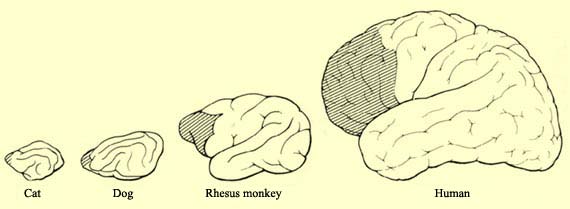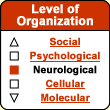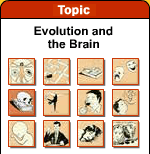|
|
| |
 |
| Our Evolutionary Inheritance |  |
| | |





The
Shrinking Human Brain: What Does It Mean?
Why
You Can Have No More Than About 150 Real Friends
The prefrontal cortex seems to contain
an especially large number of long axons, which can make connections
between various regions of the cortex that are far from one another. The larger
the prefrontal cortex, the more long axons it contains, and the more likely consciousness
is to emerge. Brain imaging also shows that the prefrontal cortex is highly active
when tasks of memorization and deductive reasoning are being performed. |
Many researchers, such as anthropologist
Robin Dunbar, say that the main selective pressure that has favoured the growth
of the neocortex in primates has been the growing complexity of their
social groups. According to Dunbar, the dramatic increase in the size
of the prefrontal cortex (compared with the various sensory cortexes, for example)
is explained by the properties of this frontal part of the brain, which have a
great deal to do with social skills.
Though primates are not capable
of elaborate systems of ethics, they do display many moral behaviours, according
to Dunbar. These behaviours of mutual
assistance and co-operation require them to trade short-term costs for long-term
gain, even though this may make them vulnerable to exploitation by more selfish
members of their society. That is why morality may be advantageous from
an evolutionary standpoint. It can strengthen group cohesion and provide a harmonious
social climate that benefits the greatest number of individuals. And what part
of the brain performs the cognitive functions needed to establish such a climate
by restraining selfish tendencies? The prefrontal cortex. |
A study was conducted of men who
had antisocial personality disorder, characterized by irresponsible
actions, cheating, impulsiveness and lack of affect or remorse, and who all had
committed violent crimes. Images of their brains revealed that the neuronal volume
of their prefrontal cortexes was 11 to 14% lower than in normal men.
The prefrontal cortex is recognized as playing an important role in individuals’
moral sensibility and self-restraint. The results of this study provide strong
evidence for this role, and raise some questions about the notion of free will
that is the basis for all law. | |
|
| THE EVOLUTIONARY LAYERS OF THE HUMAN BRAIN |
|
The various species
of vertebrates are very similar in the way that their brains are organized. For
example, all vertebrates have a
forebrain, midbrain and hindbrain, within which are found all the major neural
systems that have evolved to perform functions common to all species.
However, the various species also have areas of the brain that have specialized
in distinctive ways in response to the specific constraints of their environments.
The human brain is about three times larger in volume than we would expect in
a primate of comparable size, and the proportions of its parts to one another
are different than in other primates. For instance, in humans, the olfactory lobe
is only 30% of the size it would be if it were in the same proportion to the entire
brain as in other primates. It follows logically that if the human brain overall
is nevertheless much larger than would be expected in a primate our size, then
some of its other structures must be proportionately far larger. And indeed, when
we trace the brain’s evolution from fish to amphibians to reptiles to mammals
and finally to humans, we see that the
parts of the brain that have grown the most in human beings are in the neocortex,
and more specifically the prefrontal cortex. 
The
prefrontal cortex is the most rostral region of the cortex. In other species,
it is dedicated to voluntary motor control, but in primates, it has developed
considerably. For many years, scientists believed that humans’ unequalled
abilities for planning and abstract reasoning were attributable to their having
a more developed prefrontal cortex than other primates. But
studies conducted in the first few years of the new millennium have called this
idea into question. Earlier studies had compared the human brain to those of other
primates, but had not included most of the great apes. In these more recent studies,
magnetic resonance imaging has been used to measure the relative size of the prefrontal
cortex in all species of great apes, including humans. When this new method was
applied to this broader range of species, the relative size of the prefrontal
cortex was found to be almost the same in humans as in the great apes who are
our closest cousins (chimpanzees, bonobos, gorillas, and orangutans). According
to the authors of these recent studies, humans’ superior abilities to anticipate
and to plan can more correctly be attributed to other specialized regions of the
cortex and to denser interconnections between the prefrontal cortex and the rest
of the brain. The main reason that the prefrontal cortex is slightly larger relative
to the rest of the brain in humans than in most other primates is that humans
have a larger volume of white
matter in their prefrontal cortex. This white matter is composed of myelin-covered
axons that communicate with other parts of the brain, thus providing greater
connectivity between the prefrontal cortex and the rest of the brain than in other
species.
The high, straight forehead
that characterizes modern humans, superceding the prominent brow ridges of others
hominids, is due to the expansion of the cortex, and especially the prefrontal
cortex, in our species. 
1.
Australopithecus robustus 2. Homo habilis 3. Homo erectus
4. Homo neanderthalensis 5. Homo sapiens sapiens |
This connectivity is essential for the proper
functioning of our working
memory, in which the prefrontal cortex plays an active role. Working memory
is involved in many of the cognitive abilities that are so highly developed in
humans, such as the abilities to retain information while performing a task, to
verify the relevance of this information to the task in progress, and to keep
the objective of the task in mind at the same time. Patients who suffer severe
injuries to their prefrontal lobes can experience difficulties in relating the
past, present, and future and hence in planning their actions. This phenomenon,
known as “frontal syndrome”, confirms the primary role that this part
of the cortex plays in anticipation and in choices of all sorts.
The
recent expansion of the prefrontal cortex, together with the increased plasticity
and associative capacities of the neocortex, thus seems to be the source of many
of the most typically human cognitive abilities.
Though an increase in
the
size of the brain does not automatically confer any evolutionary advantage on
the species concerned, it has been observed that in the process of hominization,
the hominid species with smaller brains were gradually replaced by species with
larger ones. Some inventive hypotheses have been advanced to explain this
phenomenon. For example, some theorists argue that the greater associative capacities
of individuals with larger brains enabled them to make more unpredictable behavioural
responses. In turn, selective pressure would then have been exerted on other members
of their species to develop larger brains so that they could better predict these
responses — an essential survival skill among social species. These larger
brains would then have generated even more unpredictable behaviours. The positive
feedback loop thus established would have been responsible for this tendency toward
increased brain size in primates. The concept of a positive feedback
loop provides another way of accounting for evolution’s apparent tendency
toward greater complexity. In this case, the selective pressure is seen as being
generated by the evolutionary changes themselves. This pressure is also entirely
dependent on the particular context of the human evolutionary line, with its highly
developed social behaviours. |
Close parallels can be drawn between
the way that the brain has evolved in our species and way that it develops in
an individual. In individuals, just as in species, mutations can arise, and they
can have a significant impact on the adult’s morphology. Even though it
is the adult individual who has been subjected to the selective pressure of the
environment, it is that individual’s genetic development program that will
eventually be selected and passed on to his or her descendants.
Many
researchers think that the expansion of the neocortex in general and the prefrontal
cortex in particular might be explained by mutations in a limited number of genes
at an early stage of development. These mutations would
have resulted in the duplication of certain areas of the cortex, exactly as is
observed for certain genes in the genome. As in the case of genes, one
of the possible advantages of this duplication would be that one particular cortical
region could evolve rapidly while its duplicate continued to perform the basic
function originally assigned to it. |
|
|






